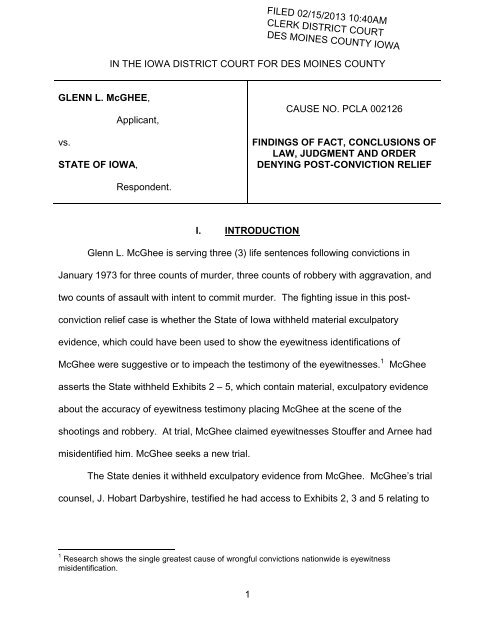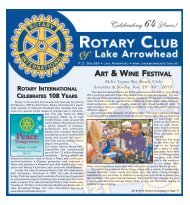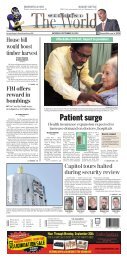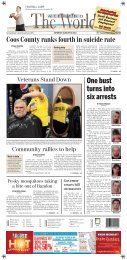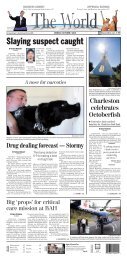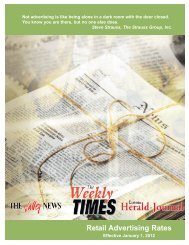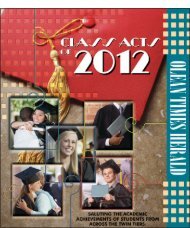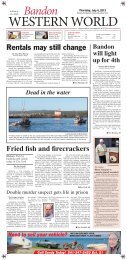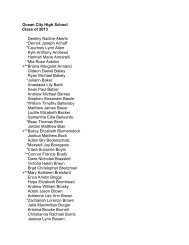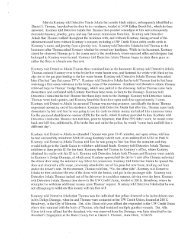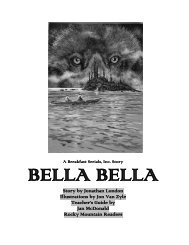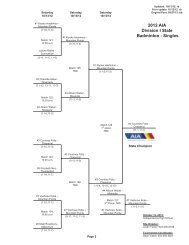1 IN THE IOWA DISTRICT COURT FOR DES ... - TownNews.com
1 IN THE IOWA DISTRICT COURT FOR DES ... - TownNews.com
1 IN THE IOWA DISTRICT COURT FOR DES ... - TownNews.com
You also want an ePaper? Increase the reach of your titles
YUMPU automatically turns print PDFs into web optimized ePapers that Google loves.
FILED 02/15/2013 10:40AM<br />
CLERK <strong>DISTRICT</strong> <strong>COURT</strong><br />
<strong>DES</strong> MO<strong>IN</strong>ES COUNTY <strong>IOWA</strong><br />
<strong>IN</strong> <strong>THE</strong> <strong>IOWA</strong> <strong>DISTRICT</strong> <strong>COURT</strong> <strong>FOR</strong> <strong>DES</strong> MO<strong>IN</strong>ES COUNTY<br />
GLENN L. McGHEE,<br />
Applicant,<br />
vs.<br />
STATE OF <strong>IOWA</strong>,<br />
CAUSE NO. PCLA 002126<br />
F<strong>IN</strong>D<strong>IN</strong>GS OF FACT, CONCLUSIONS OF<br />
LAW, JUDGMENT AND ORDER<br />
DENY<strong>IN</strong>G POST-CONVICTION RELIEF<br />
Respondent.<br />
I. <strong>IN</strong>TRODUCTION<br />
Glenn L. McGhee is serving three (3) life sentences following convictions in<br />
January 1973 for three counts of murder, three counts of robbery with aggravation, and<br />
two counts of assault with intent to <strong>com</strong>mit murder. The fighting issue in this postconviction<br />
relief case is whether the State of Iowa withheld material exculpatory<br />
evidence, which could have been used to show the eyewitness identifications of<br />
McGhee were suggestive or to impeach the testimony of the eyewitnesses. 1<br />
McGhee<br />
asserts the State withheld Exhibits 2 – 5, which contain material, exculpatory evidence<br />
about the accuracy of eyewitness testimony placing McGhee at the scene of the<br />
shootings and robbery. At trial, McGhee claimed eyewitnesses Stouffer and Arnee had<br />
misidentified him. McGhee seeks a new trial.<br />
The State denies it withheld exculpatory evidence from McGhee. McGhee’s trial<br />
counsel, J. Hobart Darbyshire, testified he had access to Exhibits 2, 3 and 5 relating to<br />
1 Research shows the single greatest cause of wrongful convictions nationwide is eyewitness<br />
misidentification.<br />
1
the identification of McGhee by State witnesses. Therefore, the State requests<br />
McGhee’s Application be denied.<br />
For the reasons stated below, the Court F<strong>IN</strong>DS McGhee has failed to establish<br />
any of his claims for post-conviction relief by a preponderance of the evidence.<br />
Consequently, his Application must be DENIED.<br />
II.<br />
BACKGROUND FACTS<br />
On January 19, 1972 six men were involved in a robbery at the Shamrock Tavern<br />
in Davenport, Iowa. The bartender and two of the bar’s patrons were shot and killed<br />
during the robbery. Other bar patrons were injured. Glenn McGhee, then age 17, was<br />
charged with three counts of murder and aggravated robbery and two counts of assault<br />
with intent to <strong>com</strong>mit murder. Attorneys J. Hobart Darbyshire and John Molyneaux<br />
were appointed to represent McGhee. Darbyshire acted as lead defense counsel. He<br />
had graduated from law school in 1967, and then served as a law clerk to Iowa<br />
Supreme Court Justice Clay LeGrand. Attorney Molyneaux assisted Darbyshire with<br />
legal research and trial preparation.<br />
During pretrial stages, defense counsel filed a number of Motions, including a<br />
Motion To Produce exculpatory evidence. See paragraph 4. A major fact issue at trial<br />
was the ability of eyewitnesses to positively identify McGhee as a perpetrator of the<br />
robberies and shootings. Darbyshire also filed a Motion To Suppress and Motion For<br />
Voir Dire of Identification Witnesses Out Of The Presence Of The Jury (Motion).<br />
In the Motion, counsel alleged that police conducted a number of photo lineups during<br />
which the alleged victims were shown pictures of the defendants, including McGhee.<br />
Counsel argued the lineups were suggestive, tainted and conducted in violation of<br />
2
McGhee’s rights under the Fifth and Sixth Amendments of the United States and Iowa<br />
Constitutions.<br />
Counsel further argued that McGhee had been required to participate in multiple<br />
lineups without the benefit of counsel. Darbyshire alleged that one such lineup occurred<br />
on May 5, 1972 while he was present in the building where the lineup occurred but was<br />
not permitted to be present in the room where the lineup took place. Finally, Darbyshire<br />
requested the Court to examine identification witnesses outside the presence of the jury<br />
during trial. See Motion filed January 2, 1973.<br />
On January 10, 1973 Darbyshire also filed a Motion In Limine stating that<br />
witnesses Allen C. Stouffer and William Arnee testified on May 24 – 25, 1972 (the<br />
Sherman White trial) during an “in-court identification that they could not identify<br />
McGhee as a participant in the robbery/shootings at the Shamrock Tavern.” McGhee’s<br />
counsel argued that because the witnesses were unable to identify McGhee before trial,<br />
they should not be allowed to make an in-court identification during trial. This Motion<br />
was eventually denied after hearing.<br />
The Court heard arguments on the Motion To Produce and Motion To Suppress<br />
on January 15, 1973. The Court granted paragraph 2 but denied paragraphs 1, 3 and 4<br />
of the Motion To Produce. See trial transcript pages 5 – 6. The Court granted the<br />
Motion To Suppress to the extent the Court authorized the Defendant to voir dire each<br />
identification witness outside the presence of the jury. Trial transcript page 6, lines 5 –<br />
19.<br />
3
At the Motion hearing, counsel stipulated there was only a single in-person<br />
identification involving McGhee. This was held May 5, 1972 with defense counsel in the<br />
general area but while not in the room with the individuals making the identification.<br />
Following a week-long jury trial in mid-January 1973, McGhee was convicted of<br />
all charges and sentenced to serve life in prison. McGhee appealed the convictions and<br />
sentences to the Iowa Supreme Court. The sole issue raised on appeal was whether<br />
the trial court improperly denied him a psychiatric evaluation to determine his criminal<br />
responsibility at the time of the offense. 220 N.W.2d 908 (Iowa 1974). The Court<br />
affirmed the convictions and sentences.<br />
McGhee later brought a federal habeas action which was denied at the district<br />
court level and circuit court level. See McGhee v. Nix, No. 4-89-CV-80683 S. D. Iowa,<br />
43 F. 3d 675 (8 th Cir. 1994). This Court also believes McGhee brought a state court<br />
post-conviction action, which was denied. McGhee v. State, 468 N.W.2d 473 (Iowa<br />
1991). Neither party provided the Court with copies of the briefs, arguments, or rulings<br />
filed in either the post-conviction action or federal habeas action. McGhee filed the<br />
current post-conviction action on May 15, 2003, almost ten years ago. The Court<br />
appointed counsel for him later.<br />
At the trial on the merits held in this action, the parties appeared by counsel. The<br />
Court received into evidence Petitioner’s Exhibits 1 – 5, and Respondent’s Exhibit A.<br />
Exhibits 2 – 5 are the documents McGhee asserts the State withheld from him. The<br />
Court also received the depositions of Mr. McGhee and his trial counsel. The Court<br />
took judicial notice of the trial court file State v. McGhee, Scott County Cause No.<br />
16012, Des Moines County Cause No. 6871 (on change of venue) and the trial court<br />
4
transcript (one volume). Final arguments were heard August 3, 2012, at which time the<br />
case was deemed submitted for ruling.<br />
III.<br />
APPLICATION <strong>FOR</strong> POST-CONVICTION RELIEF:<br />
GROUNDS PRESENTED<br />
When McGhee filed his pro se Application on May 15, 2003, 2 he alleged “there<br />
exists evidence of material facts, not previously presented and heard, that requires<br />
vacation” of his convictions and sentences. He argued (1) the State of Iowa withheld<br />
evidence; (2) he was denied effective assistance of counsel; and (3) there was<br />
unspecified newly discovered evidence. In support of these contentions, he cited White<br />
v. Helling, 194 F. 3d 937 (8 th Cir. 1999). Sherman White was one of McGhee’s codefendants.<br />
He was granted a new trial recently. The decision of White v. Helling is<br />
discussed in greater detail below.<br />
On June 22, 2004 McGhee wrote the Court stating:<br />
“My post-conviction needs to be amended because I didn’t<br />
really know how to fill it out.”<br />
On May 26, 2009 the State filed an Answer generally denying McGhee was<br />
entitled to any relief. 3<br />
On November 9, 2009 the Court entered an Order requiring<br />
McGhee’s counsel “to recast the application” by January 2, 2010. In spite of this order,<br />
the application was not recast by January 2, 2010. On September 21, 2010 the Court<br />
appointed substitute counsel to represent McGhee.<br />
On June 9, 2011 McGhee, acting pro se, filed a Motion For New Trial asserting<br />
the “D.A. withheld material evidence,” citing White v. Helling, supra. On January 10,<br />
2 This case has taken far too long to litigate due to a variety of factors, including multiple changes of<br />
counsel for Mr. McGhee. The delay has been embarrassingly long, and reflects no credit on the judicial<br />
system. See White v. Helling, 194 F. 3d 937, 946 n. 6 (8 th Cir. 1999).<br />
3 It appears from McGhee’s deposition that he filed an application for post-conviction relief and a federal<br />
habeas corpus action at an earlier time, but, if so, the record does not demonstrate the basis for these<br />
legal actions or the disposition of either.<br />
5
2012 McGhee, acting pro se, filed a lengthy “Statement of Facts.” He filed several<br />
similar documents after that time. Unfortunately, however, no recast or amended<br />
Application has ever been filed. Such short<strong>com</strong>ing leaves the Court with less guidance<br />
than it would like to have about McGhee’s claims. In the absence of a single document<br />
identifying McGhee’s claims, the Court has carefully reviewed the multiple letters he<br />
authored and the Statements of Facts he submitted. Also, McGhee gave a deposition<br />
for use at trial. Collectively, these documents appear to set out all of McGhee’s<br />
concerns.<br />
From a review of these documents, the Court has identified these issues upon<br />
which McGhee relies to seek a new trial:<br />
1. The Scott County prosecutor withheld exculpatory evidence from<br />
McGhee’s trial counsel. Specifically, McGhee alleges there were several police reports,<br />
Exhibits 2 – 5, relating to whether the State’s witnesses could identify McGhee as a<br />
perpetrator of the crimes at the Shamrock Tavern.<br />
2. Witness Alberta Taylor was a “heroin addict” and “prostitute” and the State<br />
did not disclose this to his trial counsel. See letter of May 14, 2012.<br />
3. Trial counsel, Mr. J. Hobart Darbyshire, was ineffective because he:<br />
a) failed to properly and <strong>com</strong>pletely cross-examine State’s witness<br />
Stouffer about his ability to identify the defendants;<br />
b) failed to have State witness Arnee precluded from testifying based<br />
upon improper identification;<br />
c) failed to investigate witness Alberta Taylor, and cross-examine her<br />
about her drug addiction and prostitution;<br />
6
d) failed to investigate the use of mug shots by the State to reinforce<br />
witness identifications; and<br />
e) failed to cross-examine witnesses about a .22 caliber gun, or to<br />
bring out inconsistencies in the testimony of witnesses.<br />
The Court now discusses these grounds, the applicable facts, and relevant case<br />
law.<br />
IV.<br />
CONCLUSIONS OF LAW<br />
1. The Court has jurisdiction over the parties and the subject matter.<br />
2. The Court must decide this case based solely upon the evidence and law.<br />
Evidence is testimony in person, exhibits received by the Court, stipulations of the<br />
parties, and any other matter admitted at trial. Uniform Jury Instruction 100.4.<br />
As a fact finder, the Court may not consider sympathy, bias or prejudice toward<br />
any party. Here, as is true in most cases, there are some facts that were not put on the<br />
record. There may be one or more reasons for this. The parties must realize that the<br />
Court can decide the issues only on the evidence presented. The Court cannot go<br />
outside the record made in court to find evidence. Where the record is in<strong>com</strong>plete or<br />
evidence is lacking for any reason, the Court is required to fashion its remedy and do<br />
equity as best it can with the information, even though imperfect, found in the record.<br />
3. This proceeding is a civil action. McGhee has the burden of proof. That<br />
burden is preponderance of the evidence. Preponderance of the evidence means<br />
evidence that is more convincing than opposing evidence. Preponderance of the<br />
evidence does not depend upon the number of witnesses testifying on one side or the<br />
other.<br />
7
4. When the State filed its Answer, it did not assert a statute of limitations<br />
defense. This defense was first raised in a Motion For Summary Judgment filed<br />
February 22, 2010. At the time, there was considerable confusion about the particular<br />
grounds for relief alleged by McGhee. This Court is not certain the precise grounds for<br />
relief have since been more definitively identified, with the possible exception of the<br />
allegation relating to the alleged failure to disclose exculpatory evidence. Nevertheless,<br />
it is clear that McGhee claims his trial counsel was ineffective. This Court chooses to<br />
decide McGhee’s claims on the merits.<br />
A. WHE<strong>THE</strong>R TRIAL COUNSEL WAS <strong>IN</strong>EFFECTIVE<br />
1. Principles Of Ineffective Assistance Of Counsel<br />
The principles relating to ineffective assistance of counsel are well established.<br />
To prevail on an ineffective-assistance-of-counsel claim, a defendant must show: “(1)<br />
counsel failed to perform an essential duty; and (2) prejudice resulted.” State v.<br />
Maxwell, 743 N.W. 2d 185, 195 (Iowa 2008). Proof of the first prong of this claim<br />
requires a showing that counsel’s performance fell outside the normal range of<br />
<strong>com</strong>petency. “Trial counsel’s performance is measured objectively by determining<br />
whether counsel’s assistance was reasonable, under prevailing professional norms,<br />
considering all the circumstances.” State v. Vance, 790 N.W. 2d 775, 785 (Iowa 2010)<br />
(quoting State v. Lyman, 776 N.W. 2d 865, 878 (Iowa 2010)).<br />
Proof of the second prong requires a showing by the applicant of a reasonable<br />
probability that, but for counsel’s unprofessional errors, the results of the proceeding<br />
would have been different. State v. Artzer, 609 N.W. 2d 526, 531 (Iowa 2000). “In<br />
determining whether this standard has been met, the Court must consider the totality of<br />
8
the evidence, what factual findings would have been affected by counsel’s errors, and<br />
whether the effect was pervasive or isolated and trivial.” State v. Graves, 668 N.W. 2d<br />
860, 882 – 83 (Iowa 2003) (citing Strickland v. Washington, 466 U. S. 668, 695 – 96,<br />
104 S.Ct. 2052, 2069, 80 L. Ed. 2d 674, 698 (1984)). “[I]t is the defendant’s burden to<br />
demonstrate a reasonable probability of a different result.” State v. Reynolds, 746 N.W.<br />
2d 837, 845 (Iowa 2008).<br />
Claims of ineffective assistance involving tactical or strategic decisions of<br />
counsel must be examined in light of all the circumstances to ascertain whether the<br />
actions were a product of tactics or inattention to the responsibilities of an attorney<br />
guaranteed a defendant under the Sixth Amendment.” Anfinson v. State, 758 N.W. 2d<br />
496, 501 (Iowa 2008) (quoting Ledezma v. State, 626 N.W. 2d 134, 143 (Iowa 2001)).<br />
No person has a constitutional right to a perfect trial.<br />
Trial counsel Darbyshire represented McGhee on direct appeal. Darbyshire did<br />
not allege he was ineffective at trial. This Court is uncertain whether McGhee has ever<br />
before alleged that his trial counsel was ineffective. Significantly, he has not alleged<br />
that Darbyshire was ineffective for not asserting more grounds for relief on direct appeal<br />
such as the suggestiveness of the police lineup or photo identifications.<br />
2. Alberta Taylor<br />
McGhee claims his trial counsel failed to properly investigate the background of<br />
State witness Alberta Taylor. See McGhee Deposition page 13, lines 3 – 19. McGhee<br />
testified he knew Ms. Taylor at the time of his trial. He further stated he knew her<br />
reputation. He was not asked whether he conveyed his knowledge to his attorney.<br />
9
Ms. Taylor, then age 20, testified as a State witness at trial. See trial transcript<br />
pages 348 – 373. Taylor testified she was acquainted with McGhee and co-defendants<br />
Cunningham and Orr. She stated she saw McGhee, Cunningham and Orr the evening<br />
of January 19, 1972 at her home on E. Sixth Street. Transcript page 349, lines 1 – 8.<br />
Taylor testified McGhee had a pistol in his possession, and Cunningham had a shotgun.<br />
Transcript page 349, lines 18 – 22. She further claimed the two men with guns fired the<br />
weapons from her back porch. Transcript page 351, lines 2 – 4.<br />
When trial counsel cross-examined Taylor, she testified she did not know Glenn’s<br />
last name but she had seen him numerous times at her house. Transcript page 360,<br />
lines 15 – 24. She was sure Glenn was the person who came to her home on the 19 th<br />
of January. Taylor also gave testimony about finding a shotgun shell on the back porch<br />
on January 20. This shell was turned over to Davenport police. The shell was<br />
introduced into evidence as Exhibit 3(a). Taylor was not asked about her drug usage or<br />
if is she was a prostitute.<br />
McGhee offered no expert testimony or opinion disclosing how Darbyshire is<br />
alleged to have failed during cross-examination of Taylor. McGhee has not presented<br />
evidence that Darbyshire could have used information about Taylor’s background or<br />
lifestyle to impeach her. McGhee has failed to show that his trial counsel did not have<br />
full knowledge of Taylor’s background or, more importantly, that counsel failed to<br />
properly cross-examine Taylor. There is no evidence of any prejudice to McGhee<br />
based upon the manner or method by which trial counsel handled the witness Taylor.<br />
McGhee has failed to demonstrate counsel was ineffective regarding witness Taylor.<br />
Thus, the Court must deny McGhee relief on this ground.<br />
10
McGhee also asserts the State failed to disclose to his counsel that Taylor was a<br />
prostitute and heroin addict. However, there is little evidence in the record to support<br />
this allegation. Moreover, McGhee stated he knew Taylor’s background. McGhee<br />
failed to prove the State withheld evidence about Taylor. Furthermore, there is no<br />
evidence the information about Taylor’s lifestyle would have been admissible. Finally,<br />
the Court is unable to conclude McGhee was prejudiced. His claim for relief on this<br />
ground must therefore be denied.<br />
3. Failure To Properly Cross-Examine Other Witnesses<br />
McGhee alleges several general deficiencies in performance by his trial counsel.<br />
The Court carefully reviewed the case file and trial transcript. Counsel filed a number of<br />
pretrial motions. Both before and during trial, he consistently and repeatedly challenged<br />
the identification of McGhee as a participant in the Shamrock murders and robberies.<br />
McGhee has offered no expert testimony, indeed little evidence from any source, to<br />
criticize trial counsel or to suggest trial counsel should have done something more to<br />
challenge the identification testimony of witnesses Stouffer and Arnee. Likewise,<br />
McGhee produced no evidence to support his contention trial counsel should have<br />
cross-examined other witnesses differently or investigated the case more thoroughly.<br />
As noted, there is no expert testimony claiming trial counsel failed to perform any<br />
essential duty or was ineffective in any respect. Furthermore, McGhee has not<br />
specifically shown the out<strong>com</strong>e of his case would likely have been different if trial<br />
counsel had done something more or different.<br />
4. .22 Caliber Pistol<br />
11
McGhee also contends that trial counsel should have argued that evidence about<br />
the number of shots fired from a .22 caliber pistol he allegedly brandished could not be<br />
true because the gun held only six bullets and seven shots were fired. The Court finds<br />
this argument unpersuasive and there is no substantial evidence that counsel neglected<br />
an essential duty by not pursuing a line of questions on this subject.<br />
Under the well-established case law, McGhee has failed to establish either prong<br />
of the Strickland test. His unsupported claims of ineffective assistance of counsel must<br />
therefore fail.<br />
B. WHE<strong>THE</strong>R <strong>THE</strong> STATE OF <strong>IOWA</strong> WITHHELD MATERIAL,<br />
EXCULPATORY EVIDENCE AND WHE<strong>THE</strong>R <strong>THE</strong>RE IS<br />
NEWLY DISCOVERED EVIDENCE<br />
1. Introduction<br />
McGhee asserts the State of Iowa withheld material, exculpatory evidence from<br />
him consisting of five police reports relating to eyewitness identifications of McGhee.<br />
See Exhibits 2 – 5. He further contends these reports are newly discovered evidence.<br />
McGhee relies in substantial part upon the holding in White v. Helling, 194 F. 3d 937 (8 th<br />
Cir. 1999) discussed below.<br />
The prosecution has a duty to disclose material, exculpatory evidence. Brady v.<br />
Maryland, 373 U. S. 83 (1963). The government violates a defendant’s right to due<br />
process when it suppresses evidence “favorable to the accused ... where the evidence<br />
is material either to guilt or to punishment ....” 373 U.S. at 87. Under Brady, the burden<br />
is on McGhee to show the State of Iowa suppressed evidence, that the evidence was<br />
exculpatory, and that the evidence was material to his guilt or punishment. Evidence is<br />
material “if there is a reasonable probability that, had the evidence been disclosed to the<br />
12
defense, the result of the proceeding would have been different. A reasonable<br />
probability is a probability sufficient to undermine confidence in the out<strong>com</strong>e.” U.S. v.<br />
Bagley, 473 U.S. 667, 682 (1985).<br />
2. Discussion<br />
The critical issue at McGhee’s trial was whether the State’s witnesses could<br />
identify McGhee as a perpetrator of the robbery/shootings. Several witnesses placed<br />
McGhee in the Shamrock Tavern at the time of the shootings. First, witness Michael<br />
Mann testified he drove his father’s car to the Shamrock Tavern on January 19 with<br />
McGhee, Vesey, Orr, Sherman White and Cunningham. He stated McGhee and White<br />
went into the Shamrock for about three minutes. Transcript page 46, lines 2 – 7. The<br />
group returned to the Shamrock several minutes later. Mann testified McGhee, White,<br />
Cunningham and Orr went into the Shamrock. Mann stated Orr had a shotgun. Mann<br />
also knew McGhee had a pistol earlier in the evening. After a few minutes, the four<br />
returned to the car where Mann was waiting. Mann testified when the group returned<br />
he heard someone ask Glenn whether he shot them all, and Glenn replied yes.<br />
Transcript page 54, lines 2 – 12. The group then drove to Vesey’s home where the<br />
guns were disposed of. Transcript pages 52 – 53. McGhee did not testify at trial and<br />
thus did not deny he made these <strong>com</strong>ments. It appears Mann was never prosecuted for<br />
his role in the incident.<br />
Guy Abbott testified he was playing cards at the Shamrock on January 19, with<br />
Al Stouffer, Bill Arnee, and Harold McFarland, when a robbery occurred. Transcript<br />
page 212, lines 21 – 25. He stated “they busted the front door in, came in with a<br />
shotgun, and said: ‘This is a holdup. Raise your hands and get on the floor.’ He then<br />
13
heard a shot or two and got shot himself in the head.” Transcript page 213, lines 22 –<br />
25. He testified he could identify only one man who came into the bar – Tommy<br />
Cunningham. Transcript page 215, lines 1 – 10. Abbott participated in two lineups<br />
arranged by police. He was unable to identify any of the other defendants, including<br />
McGhee. Transcript page 217.<br />
When the State of Iowa called Al Stouffer to the stand, defense counsel<br />
requested to voir dire the witness without the jury present. The Court granted the<br />
request. Transcript pages 224 – 225. The voir dire consumed almost 40 pages of<br />
transcript. Stouffer testified he viewed pictures of suspects shown to him by police at<br />
the hospital on or about January 20. Stouffer stated he thought police showed him 10<br />
or so pictures. Transcript page 226, lines 19 – 21. He was unable to positively identify<br />
anyone at that time. Over the course of the next several days, police showed Stouffer<br />
pictures on perhaps as many as a dozen different occasions. Transcript page 227, lines<br />
19 – 23. He observed pictures both at the hospital and at home. Transcript page 228.<br />
He was unable to identify anyone when police showed him pictures at home. Transcript<br />
page 229. Stouffer testified he was “shown a lineup” at the Davenport Police<br />
Department, at which time he “think[s] I picked White.” Transcript page 229, lines 10 –<br />
18.<br />
Police showed Stouffer pictures before the Sherman White trial in May. At that<br />
time, he identified Sherman White. Transcript page 230. Stouffer attended a lineup on<br />
May 5 at the Scott County Jail. Stouffer stated he picked McGhee out of this lineup.<br />
Transcript page 236. He testified there was no doubt in his mind then about the<br />
14
identification. (emphasis added) Transcript page 236. Stouffer denied that anyone tried<br />
to influence his identification of McGhee or any other defendant.<br />
One of the lead investigators on the case testified that police started off with<br />
pictures of 10 – 12 suspects. This group did not include a photo of McGhee. Transcript<br />
page 243, lines 1 – 7. Police secured a photo of McGhee about January 23. Transcript<br />
page 243, lines 20 – 23. The police presented this photo to Stouffer at his residence<br />
about January 23 – 24. According to police, Stouffer told police that he could not be<br />
sure McGhee was involved. Transcript page 244, lines 14 – 19. Police officer Hoeper<br />
testified Stouffer looked at McGhee’s picture, hesitated, and said: “Well, maybe but I<br />
don’t want to say absolutely positive. Not until I see him in person.” Transcript page<br />
246, lines 1 – 6.<br />
Police later showed Stouffer additional photos. Hoeper testified Stouffer said<br />
“This is the man” in reference to McGhee’s photo. This occurred about March 15, just a<br />
few days before the defendants were arrested. Trial counsel asked Hoeper if he kept<br />
notes of his meetings with Stouffer. Hoeper stated he kept some. Counsel asked for the<br />
notes but Hoeper did not have them with him at trial. Counsel asked to see the notes.<br />
Transcript page 248. The State objected stating the notes were properly turned over to<br />
defense counsel only after Hoeper testified and after in camera inspection. The Court<br />
stated the State’s position was correct under State v. Mayhew. Transcript page 248.<br />
When the officer testified later during the trial in the presence of the jury, defense<br />
counsel did not renew his request for the officer’s notes. When Stouffer testified before<br />
the jury, he stated McGhee was the person who shot him. Transcript page 268, lines 1<br />
– 4. His testimony was very brief on direct. On cross, Stouffer admitted he drank 8 – 9<br />
15
eers between 5 – 5:30 p.m. and 9 p.m. He denied he was drunk. Transcript pages 271<br />
– 272. Stouffer did not recall seeing any gun other than a shotgun.<br />
Stouffer claimed he looked directly at McGhee in the Shamrock. Transcript page<br />
273, lines 19 – 22. However, he then stated he could not “swear to it” that it was<br />
McGhee who shot him. Transcript page 276, lines 6 – 8. Stouffer admitted he testified<br />
under oath at the White trial in May he was not sure he could identify McGhee,<br />
transcript page 276, lines 12 – 19, but could only say McGhee looked familiar.<br />
Transcript pages 276 – 277. This occurred with McGhee present. When asked to<br />
explain how he was not sure about McGhee at White’s trial but was certain at McGhee’s<br />
trial, Stouffer stated he was scared to identify McGhee at the White trial. Transcript<br />
page 277.<br />
Officer Hoeper testified that he showed four photos to Stouffer while he remained<br />
hospitalized. McGhee’s photo was not in this group. Several days later, about January<br />
25, Hoeper went to Stouffer’s home with about twelve pictures. Stouffer made no<br />
positive identification but said he wanted to see the persons face-to-face. Transcript<br />
page 385. On March 15, Hoeper again showed Stouffer pictures of suspects including<br />
McGhee. As he did in January, Stouffer hesitated on McGhee’s picture and stated he<br />
wanted to see the subject face-to-face. Transcript page 386.<br />
Hoeper testified further that at the lineup held May 5, Guy Abbott was unable to<br />
identify McGhee, but Arnee and Stouffer did identify McGhee. Transcript page 392.<br />
The cross-examination of Hoeper was very brief. See Transcript page 396 – 399. No<br />
mention was made of any of the reports, Exhibits 2 – 5, admitted in the post-conviction<br />
relief action. McGhee alleges these reports were withheld by the State.<br />
16
The police reports introduced into evidence as Exhibits 2 – 5 at the postconviction<br />
trial state Stouffer gave police “nothing on identification” as of March 1, 1972.<br />
See Exhibit 2. The report from March 15, 1972 states police showed Stouffer about 15<br />
mug shots, and he “picked out the mugs of Orr, Cunningham, and McGhee.” The report<br />
states: “[Stouffer] could not make positive identification at this time, but recalls seeing<br />
this group in the tavern.” Exhibit 3. The report states further:<br />
“Out of the group of mugs, he picked out that of McGhee<br />
as the man who shot him.” Exhibit 3.<br />
A report from May 14, 1972 states that Stouffer was shown five mug shots,<br />
including a mug of McGhee. Stouffer picked out “White as the man he gave his billfold<br />
to.” Exhibit 5. This report says nothing about Stouffer identifying McGhee’s mug shot in<br />
any respect. Trial counsel did not ask either Stouffer or either of the police officers in<br />
charge of the investigation any questions about the contents of this report.<br />
William Arnee testified McGhee participated in the robbery. Transcript page 317,<br />
lines 1 – 9. He also testified he heard four gunshots. Transcript page 318. Without<br />
doubt, the testimony of Arnee and Stouffer was critical to the prosecution’s case against<br />
McGhee. The testimony of Stouffer was also critical to the conviction of co-defendant<br />
Sherman White. White’s conviction was set aside in 1999 by the Eighth Circuit Court of<br />
Appeals. Because McGhee relies heavily on this case to support his claims the<br />
prosecution withheld evidence and this evidence is newly discovered, the Court<br />
discusses White in detail.<br />
3. Sherman White v. Helling<br />
Witness Allan C. Stouffer was a major witness against White as he testified<br />
White was the person to whom he gave his wallet during the Shamrock robbery. Such<br />
17
testimony was directly inconsistent with White’s defense that he was coerced to go to<br />
the Shamrock and only watched and did not participate directly. 194 F. 3d at 944.<br />
White conducted discovery during his federal habeas action and uncovered<br />
several police reports, not previously disclosed to his trial counsel, which he argued<br />
were material evidence with which he could attack the credibility of witness Stouffer.<br />
This material evidence included Exhibits 2 – 5 introduced in these proceedings by<br />
McGhee.<br />
The Court of Appeals found these documents to be significant in several<br />
respects. The report of March 1, 1972, Petitioner’s Exhibit 2, states “Stouffer – nothing<br />
on identification.” In Exhibit 3, a memo from March 15, 1972, it is reported Stouffer<br />
picked out the mug shot of Cunningham as the man he believed took his wallet.<br />
Significantly, Cunningham told authorities at about this same time he took two billfolds<br />
from a couple of men on the floor of the Shamrock. Thus, Cunningham apparently<br />
admitted he – not White – took Stouffer’s billfold. 194 F. 3d at 945.<br />
Three days later a lineup was held. Stouffer stated he was “almost sure” of two<br />
of the participants – Orr and White. This was the first time Stouffer identified White.<br />
Stouffer also stated at the lineup he was “not positive” about Cunningham. See Exhibit<br />
4. In May 1972 police interviewed Stouffer again and he picked out Sherman White as<br />
the man he gave his billfold to. See Exhibit 5.<br />
After reviewing these reports detailing Stouffer’s history of identifications, the<br />
federal Court of Appeals concluded:<br />
“This sequence of events . . . would have provided powerful<br />
ammunition for attacking the credibility of Mr. Stouffer’s in-court<br />
identification of [White] as the man who took his wallet.”<br />
18
The Court continued:<br />
“Indeed, the inference of suggestiveness is so strong that the<br />
evidence might have led the trial court to exclude the Stouffer<br />
identification altogether.”<br />
Further, the Court noted that the police reports would have been used to<br />
impeach police witnesses on the subject of the circumstances of Stouffer’s preparation<br />
for testimony and pretrial identification of White. The Court explained that Stouffer was<br />
asked at trial whether he ever identified Cunningham. Stouffer replied I don’t think so,<br />
and I don’t remember. The Court called this testimony “very likely false” in view of the<br />
March 15, 1972 report stating Stouffer picked Cunningham as the person who took his<br />
wallet.<br />
McGhee asserts that these same police reports were improperly withheld from<br />
his trial counsel. However, trial counsel testified that he had access to the reports,<br />
except for Exhibit 4, prior to trial. Darbyshire Deposition page 12, lines 16 – 21.<br />
McGhee testified he had not seen the reports nor been advised of them prior to or<br />
during his trial. Trial counsel was not asked whether he shared the reports with<br />
McGhee and, if not, why not. If the reports were not shared, McGhee’s young age and<br />
lack of substantial education may help explain counsel’s decision. Further, there may<br />
be a conflict between Darbyshire’s testimony he received the critical reports and his<br />
request during trial for Officer Hoeper’s notes regarding the meetings he held with<br />
Stouffer. On the present record, it is impossible for the Court to know whether Hoeper’s<br />
“notes” were different than the “reports” Darbyshire insisted he possessed. If the<br />
documents are the same, Darbyshire’s testimony and his request for the notes are<br />
difficult to reconcile.<br />
19
As noted, the State objected at trial to the release of Hoeper’s notes. If those<br />
notes had been given to Darbyshire earlier, there would have been no reason to object.<br />
Neither McGhee’s counsel nor the State asked questions to clarify this apparent conflict.<br />
There are some legitimate questions that could be asked of trial counsel<br />
concerning the reports, such as:<br />
1. If you had the reports, why did you not mention them directly in crossexamination?<br />
Why did you ask Hoeper for his notes?;<br />
2. If you had the reports, why did you not cross-examine officers or<br />
identification witnesses about these items:<br />
(a)<br />
Exhibit 3 – police refer to Abbott as the best of the witnesses yet he<br />
could not identify McGhee;<br />
(b)<br />
Exhibit 3 – police note if Stouffer is “coached properly” he could<br />
remember much more. To the Court it seems very important that<br />
the officers used the term “coached.” This certainly raises the<br />
possibility that improper suggestiveness of eyewitnesses occurred;<br />
(c)<br />
Exhibit 5 – police note Stouffer went over the five mug shots<br />
including one of McGhee, and picked out Sherman White as the<br />
man he gave the billfold to. There is no mention made of McGhee.<br />
Also, there is a clear indication Stouffer had now identified both<br />
Cunningham and White as the person who took his wallet.<br />
Arguably, this shows both confusion and the possibility of<br />
suggestiveness by law enforcement.<br />
20
These questions arguably amount to “second-guessing” counsel or “Mondaymorning<br />
quarterbacking.” There are undoubtedly other difficult questions that could be<br />
asked of trial counsel with the benefit of hindsight. This Court must avoid the temptation<br />
to use hindsight to require that trial counsel’s performance have been perfect. The<br />
Sixth Amendment demands only “reasonable <strong>com</strong>petence, the sort expected of the<br />
ordinary fallible lawyer.” 194 F. 3d at 941.<br />
In the end, the only evidence McGhee produced that the State withheld Exhibits<br />
2, 3 and 5 is his testimony, the inference that can be drawn from the failure to mention<br />
the reports at trial and the request for Hoeper’s notes, and the suggestion that if the<br />
State didn’t produce the documents to White’s counsel, it likely did not produce them for<br />
Darbyshire. Balanced against this evidence is Darbyshire’s testimony that he had<br />
Exhibits 2, 3, and 5. When this evidence is weighed, the Court cannot conclude that<br />
McGhee has proved by a preponderance of the evidence that the State withheld<br />
material, exculpatory evidence.<br />
The distinctions between White’s case and McGhee’s case are many. First,<br />
White did not have access to the police reports that McGhee’s counsel testified he saw<br />
and read. Next, witness Stouffer did not give directly inconsistent identifications about<br />
McGhee like he did of White and Cunningham. This inconsistency caused the Eighth<br />
Circuit to conclude Stouffer’s identification of White constituted “an inference of<br />
suggestiveness so strong” that the trial court might have excluded it. This inconsistency<br />
allowed the Court to find that Stouffer’s testimony was “very likely false.” This Court<br />
declines to draw these same conclusions about Stouffer’s testimony vis-à-vis McGhee.<br />
21
In McGhee’s case, counsel attempted without success to show the identifications were<br />
suggestive.<br />
Finally, White defended his case on the basis that McGhee coerced him to<br />
participate rather than on the basis of misidentification. The Iowa Court of Appeals<br />
described White’s coercion defense as “credible.” White v. State, 380 N.W.2d 1, 5<br />
(Iowa Ct. App. 1985). The State correctly argues these differences are so substantial<br />
that the Eighth Circuit’s holding in White can be distinguished from McGhee’s case.<br />
To the extent McGhee asserts Exhibit 4 is material, exculpatory evidence not<br />
produced to his counsel, the Court concludes McGhee failed to show Exhibit 4 contains<br />
material exculpatory evidence. Exhibit 4 is a report of Detectives Rubley and Hoeper<br />
dated March 21, 1972. The report details a photo lineup police held with several State<br />
witnesses, including Arnee and Stouffer. However, McGhee’s photo was not one of the<br />
photos displayed. Under these circumstances, the Court believes McGhee cannot<br />
show the report was material or exculpatory.<br />
CONCLUSION<br />
Based upon this analysis, the Court concludes that McGhee failed to establish by<br />
a preponderance of the evidence that his trial attorney was ineffective in any manner.<br />
Next, McGhee did not establish by a preponderance of the evidence that the State<br />
withheld police reports or other material evidence, or exculpatory evidence under Brady<br />
v. Maryland, 373 U. S. 83 (1963). Accordingly, the Application For Post-Conviction<br />
Relief is DENIED. The taxable costs, including reasonable attorney fees, are taxed to<br />
Applicant. Judgment is entered accordingly.<br />
IT IS SO ORDERED.<br />
22
Dated and signed this 15 th day of February, 2013.<br />
/s/_____________________________<br />
Michael J. Schilling<br />
District Court Judge<br />
Eighth Judicial District of Iowa<br />
michael.schilling@iowacourts.gov<br />
Certificate of Service: The undersigned certifies that a true copy of this document was served on each person named (and checked) below,<br />
including attorneys of record, or the parties where no attorney is of record, by electronic mail and/or enclosing this document in an envelope<br />
addressed to each named person at the respective addresses disclosed by the pleadings of record herein, with postage fully paid, by depositing the<br />
envelope in a United States depository or hand-delivered via courthouse mail on: ________________ (date).<br />
Copies distributed via: Email Mail<br />
_____ _____ Joel Walker<br />
_____ _____ Jerald Feuerbach<br />
_____ _____ Kimberly Shepherd<br />
_____ _____ Glenn L. McGhee, Inst. # 075700 ASPC/Eyman/SMU-1 Unit, PO Box 4000, Florence, AZ 85132<br />
By: _______________________<br />
23


